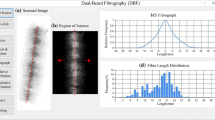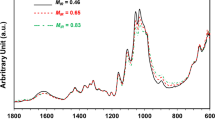Abstract
The quality of cotton yarn, such as evenness and strength, relies on not only the overall length of spun fibers but also fiber length uniformity. In the current cotton classification system (Cotton Incorporated in Classification of upland cotton, 2018; USDA in The classification of cotton, Agricultural Marketing Service, Washington, DC, 1995), length uniformity is measured by a single factor—uniformity index (UI), which does not explicitly include short fiber content (SFC) and neglects the interactive effects among length attributes. The goal of this study was to search for key length attributes and new classification methods for more comprehensive evaluations of cotton length uniformity. We firstly investigated the associations of length attributes measurable by the dual-beard fibrography (DBF) (Zhou et al. in Text Res J 90(1):37–48, 2020) to select a set of key features to reduce the dimensionality for consecutive statistical analysis. This set contains an overall length attribute (upper half mean length—UHML), SFC and UI that represent more realistic information about cotton quality. We then used the K-means clustering to determine the natural clusters of the length uniformity based on the data of 29 selected cotton samples that have a wide range of fiber length distributions. The clustering resulted in six optimal clusters, each representing a group of homogeneous length attributes. Thirdly, we adopted one support-vector-machine (SVM) classifier for cotton length uniformity prediction on unknown fibers. To verify the prediction accuracy, 25 new specimens were taken from the 29 samples used in the K-mean clustering to run the DBF test and the SVM classification. It was found that 92% of these specimens yielded the same cluster numbers as the ones resulted from the clustering. In summary, UHML, SFC and UI represent more comprehensive length attributes of cotton, and the six new clusters from the K-mean clustering offer more holistic evaluation on cotton length uniformity.






Similar content being viewed by others
Availability of data and material
Cotton length attribute data are available upon request. The cotton samples were collected from Texas Tech University and Cotton Incorporated.
References
Adi A, Çelebi E (2014) Classification of 20 news group with Naïve Bayes classifier. In: 22nd signal processing and communications applications conference (SIU), Trabzon, IEEE: 2150–2153
Azzouz B, Hassen M, Sakli F (2007) Generation of length distribution, length diagram, fibrogram, and statistical characteristics by weight of cotton blends. Model Simul Eng 2007:1–13. https://doi.org/10.1155/2007/27521
Bragg C, Shofner F (1993) A rapid, direct measurement of short fiber content. Text Res J 63(3):171–176
Breuer J, Farber C (2008) Determination of optimum machine settings with intelligent systems. Melliand Int 14(2):88
Cheng Y, Cheng K (2002) A comparison of HVI, AFIS and traditional cotton testing method
Cotton Incorporated (2018) Classification of upland cotton. https://www.cottoninc.com/cotton-production/quality/classification-of-cotton/classification-of-upland-cotton/, the latest website visit was on 1/6/2020
Gorade S, Deo A, Purohit P (2017) A study of some data mining classification techniques. Int Res J Eng Technol (IRJET) 4(4):3112–3115
Ibrahim RM, Ghani A, Embat AMMS (2013) Organizational citizenship behavior among local government employees in east coast Malaysia: A pilot study. Int Bus Res 6(6):83–94
International Trade Center UNCTAD/WTO (2007) Cotton exporter’s guide. Product and Market Development, Geneva
Jayanthi D, KaviPriya C (2018) Clustering approach for classification of research articles based on keyword search. Int J Adv Res Comput Eng Technol (IJARCET) 7(1):86–90
Jin J, Xu B, Wang F (2018) Measurement of short fiber contents in raw cotton using dual-beard images. Text Res J 88(1):14–26
Kelly C, Hequet E, Dever J (2012) Interpretation of AFIS and HVI fiber property measurements in breeding for cotton fiber quality improvement. J Cotton Sci 16:1–16
Krifa M (2006) Fiber length distribution in cotton processing: dominant features and interaction effects. Text Res J 76:426–435
Kumar V, Kalitin D, Tiwari P (2017) Unsupervised learning dimensionality reduction algorithm PCA for face recognition. In: 2017 international conference on computing, communication and automation (ICCCA), pp 32–37
Lang C, Wu M, Xu B et al (2020) Algorithm for measuring fiber length distributions of raw cotton and combed wool using dual-beard image method. Text Res J. Online First, https://doi.org/10.1177/0040517520913525
Mohamad I, Usman D (2013) Standardization and its effects on K-means clustering algorithm. Res J Appl Sci Eng Technol 6(17):3299–3303
Osisanwo F, Akinsola J, Awodele O et al (2017) Supervised machine learning algorithms: classification and comparison. Int J Comput Trends Technol 48(3):128–138
Pabich A, Frydrych I, Raczynska M et al (2010) The length control–a comparative analysis of cotton length parameters. In: 7th international conference - TEXSCI 2010, Liberec, Czech Republic 579–585
Patil S, Kulkarni U (2019) Accuracy prediction for distributed decision tree using machine learning approach. In: 2019 3rd international conference on trends in electronics and informatics (ICOEI) IEEE: 1365–1371
Raschka S (2018) Model evaluation, model selection, and algorithm selection in machine learning. arXiv preprint arXiv:1811.12808, Cornell University
Robert W (2012) Detecting and correcting violations of regression assumptions. SAGE Publications, Inc., Thousand Oaks, pp 287–304. https://doi.org/10.4135/9781452230122
Rojas-Domínguez A, Padierna L, Valadez J et al (2017) Optimal hyper-parameter tuning of SVM classifiers with application to medical diagnosis. IEEE Access 6:7164–7176
Sachin D (2015) Dimensionality reduction and classification through PCA and LDA. Int J Comput Appl 122(17):4–8
Shekar B, Dagnew G (2019) Grid search-based hyperparameter iuning and classification of microarray cancer data. In: 2019 second international conference on advanced computational and communication paradigms (ICACCP) IEEE, pp 1–8
Sohanur M, Sobuj R (2016) Length parameters of cotton fibers. Textile Study Center. https://textilestudycenter.com/length-parameters-cotton-fibers/, the latest website visit was on 04/18/2020
Techvidvan Team (2020) SVM Kernal Functions-‘Coz your SVM knowledge is incomplete without it’. TechVidvan. https://techvidvan.com/tutorials/svm-kernel-functions/. Accessed 7 Mar 2020
Teodoro P, Carvalho L, Rodrigues J et al (2018) Interrelations between agronomic and technological fiber traits upland cotton. Acta Sci Agron 40:1–7
Thibodeaux D, Senter H, Knowlton J et al (2008) The impact of short fiber content on the quality of cotton ring spun yarn. J Cotton Sci 12(4):368–377
USDA (1995) The classification of cotton. Agricultural Marketing Service. Washington, DC, USA. https://naldc.nal.usda.gov/download/CAT10825960/PDF, the latest website visit was on 04/18/2020
Vasan K, Surendiran B (2016) Dimensionality reduction using principal component analysis for network intrusion detection. Perspect Sci 8:510–512
Zhou J, Xu B (2020) Reliability of cotton length distributions measured by dual-beard fibrography and advanced fiber information system. Cellulose (under review)
Zhou J, Wang J, Wei J et al (2020) Extracting fiber length distributions from dual-beard fibrograph with the Levenberg-Marquardt algorithm. Text Res J 90(1):37–48
Acknowledgments
We are grateful to Drs. Eric Hequet and Noureddine Abidi of Texas Tech University, and to Dr. Neha Kothari for the cotton samples and data provided for this project.
Funding
The research was funded by a grant from Cotton Incorporated, USA (Grant No. 17-016).
Author information
Authors and Affiliations
Contributions
Jinfeng Zhou performed the cotton tests, analyzed the data and drafted the manuscript. Bugao Xu guided the research and finalized the manuscript.
Corresponding author
Ethics declarations
Conflict of interest
None.
Code availabity
Upon request.
Additional information
Publisher's Note
Springer Nature remains neutral with regard to jurisdictional claims in published maps and institutional affiliations.
Rights and permissions
About this article
Cite this article
Zhou, J., Xu, B. Evaluating cotton length uniformity through comprehensive length attributes measured by dual-beard fibrography. Cellulose 27, 7861–7871 (2020). https://doi.org/10.1007/s10570-020-03326-z
Received:
Accepted:
Published:
Issue Date:
DOI: https://doi.org/10.1007/s10570-020-03326-z




